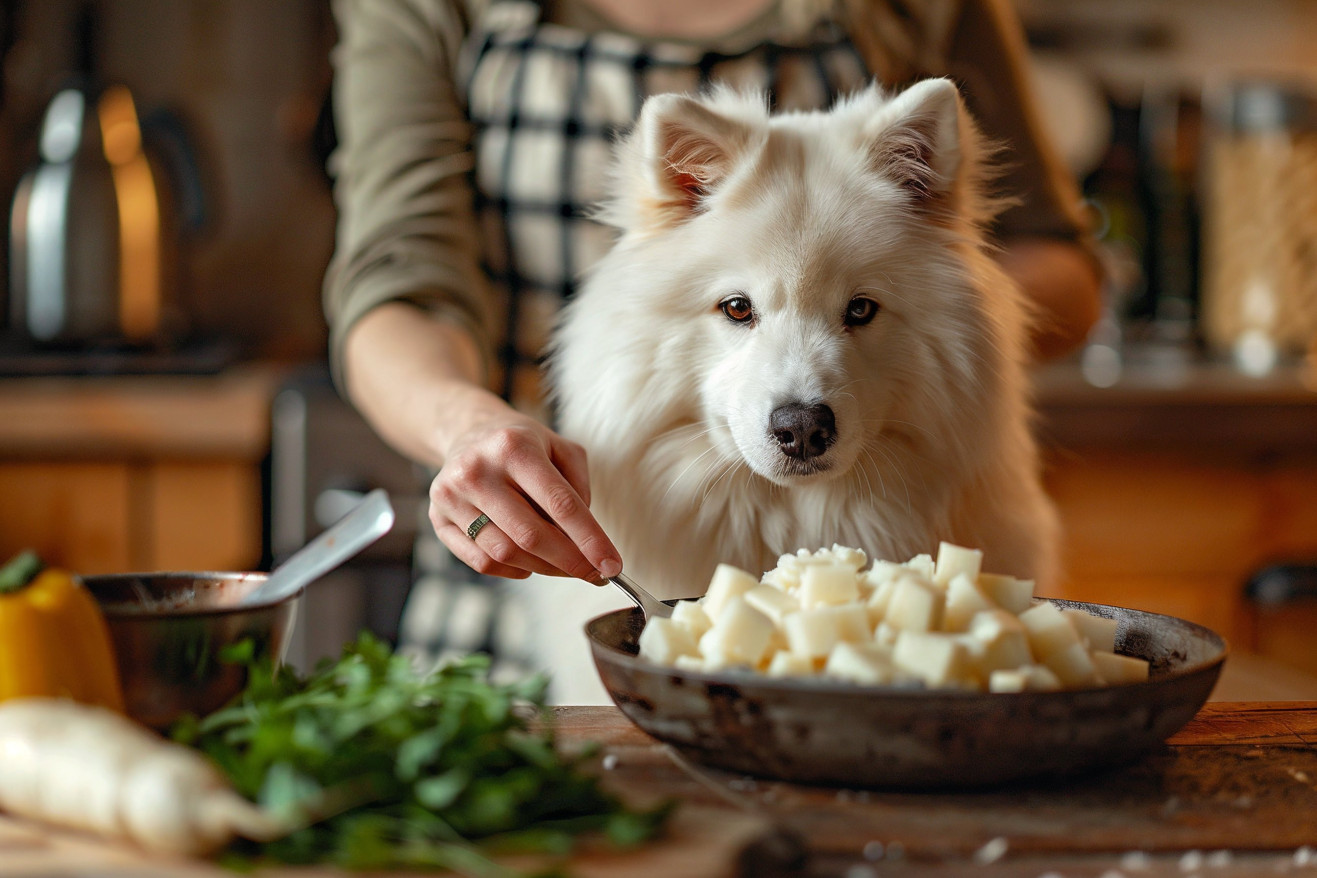Can Dogs Eat Parsnips? A Nutritional Guide for Pet Owners
8 March 2024 • Updated 7 March 2024

If you’re a dog owner who loves to snack on veggies, you may have found yourself wondering if you can share your latest favorite, parsnips, with your furry friend. The good news is that dogs can eat parsnips, but as with most things, it’s best to do so in moderation.
Parsnips are full of important nutrients like vitamins and fiber, but they should only be fed to dogs when cooked and free of any seasonings like salt or garlic, which can be toxic. As always, make sure to check with your vet before adding anything new to your dog’s diet.
This article will take a deep dive into the nutritional value of parsnips for dogs. We’ve referenced veterinary and animal nutrition experts and studies to give you the most up-to-date and accurate information on the pros and cons of feeding parsnips to dogs. You’ll also find out how to add this healthy treat to your dog’s diet in a way that will support their overall health and happiness.
Can dogs eat parsnips?
Parsnips: A Healthy Dog Treat
Parsnips are a root vegetable that can be a nutritious and healthy treat for dogs if they are prepared and served properly. According to Verywell Fit, parsnips are packed with essential vitamins and minerals like magnesium, potassium, vitamin C, and folate, all of which are important for your dog’s health. These nutrients help with everything from maintaining a healthy heart to ensuring strong bones and a healthy immune system.
That said, it’s important to remember that everything should be done in moderation, especially when it comes to high-fiber foods like parsnips. As Animal Wellness Magazine explains, while fiber is important for digestion and can help with weight management and blood sugar levels, it can be problematic if consumed in large amounts, especially for dogs with certain health issues like kidney disease, because of the high potassium levels in parsnips.
In terms of portion size, it’s important to take your dog’s size and dietary needs into account.
As a general rule, a small portion of steamed parsnips mixed in with their regular food can be a healthy addition.
Parsnips are a little higher in sugar than some other vegetables dogs can eat, so they should be fed in moderation to avoid potential health problems. That said, if you’re careful about how you feed them to your dog, parsnips can be a great way to help ensure that they get the nutrients they need and add some variety to their diet.
How to Prepare Parsnips for Dogs
If you want to feed your dog parsnips, it’s important to know that how you prepare them matters. Canine Nutritionist recommends boiling, steaming, mashing, or pureeing parsnips. These methods will help maintain the nutrients in the parsnips while making them easier for dogs to eat and digest. In addition, experts recommend keeping the skin on to retain most of the nutrients.
You should also be careful to avoid any seasonings or other ingredients that could be harmful to dogs, as tails.com notes. For example, members of the Allium family, like garlic and onions, as well as salt and oils, can be toxic to dogs. This means that plain parsnips are the best option, as you can be sure that none of these ingredients are present.
It’s also important to be mindful of portion sizes, especially for dogs with specific dietary concerns like kidney disease or diabetes, because parsnips are high in fiber and potassium.
As a general rule, you should start with a small amount, like a half cup of chopped parsnips, and monitor your dog for any negative side effects.
You can also try sprinkling raw parsnip on top of your dog’s regular food or mixing mashed parsnip in with their regular meals. By introducing parsnips slowly, you can see how your dog reacts and adjust as needed, making sure that the transition is smooth and safe.
Rooted in Health: Parsnips as Part of a Well-Balanced Diet
A well-balanced diet is essential for dogs to live long and healthy lives. The American Animal Hospital Association (AAHA) Nutrition and Weight Management Guidelines for 2021 explains that in order to help dogs achieve an optimal body condition and meet their nutritional needs, it is important to create a personalized feeding plan that includes a variety of food groups.
Vegetables are an important part of this, and Dogs Naturally Magazine recommends that they make up about 10% of a dog’s diet. Root vegetables, including parsnips, can be a helpful part of this, providing a source of vitamins and fiber.
Parsnips, in particular, can be a sensible way to help meet a dog’s nutritional needs if they are included in the diet in the right way. As the Whole Dog Journal points out, while root vegetables, including parsnips, are safe for dogs and provide important nutrients, they are high in sugar and should be fed in moderation.
The key to feeding parsnips to dogs is to make sure they are part of a balanced diet that is tailored to the dog’s individual needs. While they can help to add to a dog’s diet, pet parents need to be aware of the potential downsides of overfeeding vegetables, including gastrointestinal problems and nutritional deficiencies.
If they are included properly, parsnips can help to make sure that a dog’s diet is well-rounded and supports their health without leading to the problems that can come with overconsumption.
How to Spot and Deal With Food Allergies in Dogs
While parsnips are not a common source of food allergies in dogs, it’s important for dog owners to know the more common ones. A study in PMC showed that the most common allergens for dogs are beef, dairy, chicken, and wheat. Allergic reactions can cause symptoms like itchy skin and stomach issues, and can also lead to more serious problems such as chronic ear infections and dermatitis.
If you think your dog may be allergic to a certain food, the Clinical Nutrition Service at Cummings School says that an elimination diet is the gold standard for diagnosis. This means that you’ll need to feed your dog a diet that includes novel ingredients that they haven’t been exposed to in the past, see if there’s any improvement, and then reintroduce the original diet to confirm the allergy.
DVM360 explains that allergy testing needs to be done under the supervision of a vet to make sure that the testing is safe and healthy for your dog and to help you with the elimination diet trial.
Once an allergen is identified, a vet can help you manage your dog’s diet to make sure that they don’t consume the ingredients that cause the allergy, which will help keep them healthy and prevent future allergic reactions.
Knowing how to deal with food allergies is one way to make sure that your pet has a happy and healthy life, complete with a well-balanced diet that meets their unique needs.
Dietary Fiber and Digestive Health in Dogs
Dietary fiber has a number of different effects on the digestive system, and it can also impact a dog’s overall health. For example, Dr. Julie Buzby explains that while dogs don’t have a nutritional requirement for fiber, it can help with a number of things, including ensuring regular bowel movements and helping with weight control.
Getting the right amount of fiber in a dog’s diet can also help prevent constipation and diarrhea, which are common concerns for dog owners.
A study in the American Journal of Veterinary Research even found that fermentable fibers, like those found in parsnips, can improve stool quality and increase the number of good bacteria in the gut. Meanwhile, a study from the Clinical Nutrition Service at the Tufts Cummings School of Veterinary Medicine found that the type and amount of fiber in a dog’s diet should be tailored to the dog’s specific health issues.
Meanwhile, a study in the Journal of the American Veterinary Medical Association found that the inclusion of an appropriate amount of soluble fiber in the diet is important for managing dogs with certain gastrointestinal diseases, such as chronic large bowel diarrhea. This means that dog owners should work with a veterinary nutritionist to make sure they’re feeding their dog the right amount and type of fiber if they’re dealing with digestive issues.
When fed in moderation and as part of a nutritionally balanced diet, parsnips can be a healthy source of dietary fiber that can support a dog’s digestive health.
Conclusion: Adding Parsnips to Your Dog’s Diet
In conclusion, parsnips can be a healthy treat for your dog, providing them with essential vitamins, minerals, and fiber that can help support their overall health.
However, the key to adding parsnips to your dog’s diet is to do so in moderation and to prepare them in a way that makes them safe for your dog to eat. When steamed or boiled and served without any seasonings that can be toxic to dogs, parsnips can be a healthy addition to your dog’s regular diet.
Always talk to your vet before you add anything new to your dog’s diet. Your vet can help you determine the right portion size for your dog’s treats, including parsnips, and can also help you ensure that you’re meeting your dog’s specific dietary needs. After all, while treats are important, they should only be a small part of your dog’s overall, nutritionally complete diet.
As pet parents, it’s important to make sure we’re making informed decisions about our dogs’ diets. By adding healthy options like parsnips to our dogs’ diets in a way that’s safe and healthy, we can make sure we’re supporting our dogs’ overall health and well-being.


